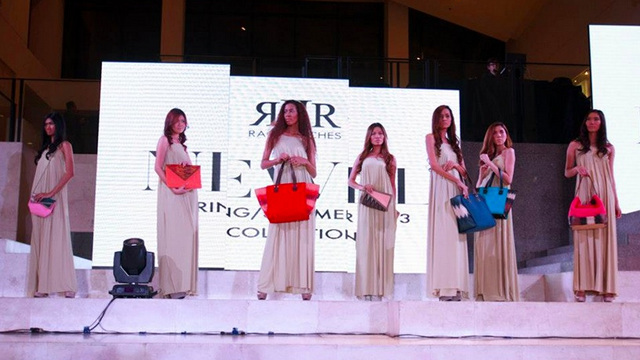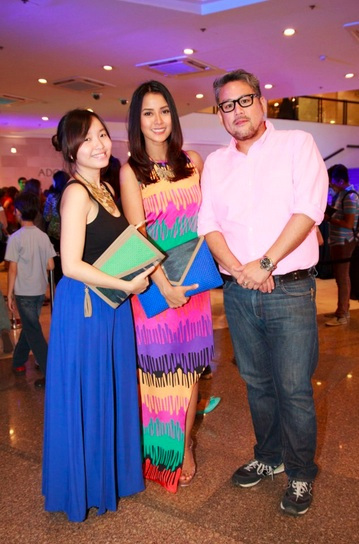SUMMARY
This is AI generated summarization, which may have errors. For context, always refer to the full article.

MANILA, Philippines – Reese Fernandez-Ruiz started her social enterprise, Rag2Riches, in 2007 when she discovered the need to help the women of Payatas, once one of the biggest garbage dump sites in the Philippines.
From creating foot rugs to stylish bags, Rags2Riches has successfully opened up job opportunities that extend far beyond the Payatas community. Reese has attracted strong supporters with her entrepreneurial mindset, creativity, and passionate heart.
Rappler talks to Reese about how this journey began and its positive evolution in both the fashion and economic scene.
Rappler: What is Rags2Riches all about?
Reese: What started out as a small livelihood project grew into a platform for artisans to get out of poverty. Rags2Riches, Inc. is committed to improving the quality of life of Filipino artisans living in less advantaged communities.
We provide a fully integrated and sustainable livelihood platform to communities who desire to increase their incomes, gain access to social services, and build a roadmap for them and their families to get out of poverty. Our platform consists of 3 basic building blocks, the key success factors to achieve scale and sustainability: design intergration, skills training, and market access.
Through design integration, we are able to transform scrap, organic, and indigenous raw materials into stylish and functional home and fashion accessories by partnering with a team of renowned local and international designers (Rajo Laurel, Amina Aranaz-Alunan, Oliver Tolentino, Olivia d’Aboville, and soon, Kenneth Cobonpue). The infusion of creativity and innovation into our materials and techniques creates value for our products and our brand.
Through skills training, we equip community artisans with the necessary skills and tools to create the products launched in the market. As their capacity to create increases, so does their earning capacity. Furthermore, we also provide training for life skills, values formation, basic business management, and financial literacy.
Market access means we build access for the artisans’ products in the formal economy by penetrating both retail and corporate markets with a brand positioned as stylish, sustainable, and handmade

What situation was happening in Payatas that made you start Rags2Riches?
One of the most popular means for livelihood in Payatas is rug weaving. Around 15 years ago, a group of stay-at-home mothers discovered scraps of cloth thrown in the dumpsite. They wove these scraps into foot rugs that they sold in the market or along the streets, while their husbands worked in factories and as contractual workers in companies.
When the world economic crisis happened, a lot of the factories and companies in the Philippines closed down or transferred to other more cost efficient countries, leaving a lot of Filipinos jobless. The husbands of the Payatas women took fewer jobs because of this and the earning pressure fell on the women.
However, the rising unemployment also gave birth to another set of informal workers: the middlemen. These enterprising but often-unscrupulous middlemen and women sourced the scraps of cloth directly from garment factories. They sold the scraps from one person to another and by the time it reached the Payatas women, the price of the scraps already quadrupled. Another set of middlemen and women would then purchase the finished rugs from the Payatas women for a few cents, and sell to another set of buyers before the item reaches the market. Because of this unfair trade, the Payatas women earned less than US$0.20 per day. This is barely enough to feed one person for one meal, let alone to sustain a family.
The Payatas situation is not unique to Payatas alone. There are millions of enterprising Filipinos with raw skills who do not have the opportunity to rise above poverty even through hard work and determination. They are the 50% struggling and vulnerable Filipinos who are mostly self-starters, hard workers, but disenfranchised and excluded. Their situation is tipping on a balance. Thus, most of them are left with little choice but to participate in illegal activities, informal markets, and even unfair trade.
What steps did you take in response to this problem?
The first thing Rags2Riches did was to take out the middlemen/women and link the Payatas mothers straight to the garments factories and the market. We initially collaborated with 3 Payatas mothers to highly improve the quality and value of the foot rugs they were already making. We all wanted to go beyond “pity buy” and not sell the products only for the cause. When we started getting small successes in bazaars and fairs, using our donated US$200 start up capital, more mothers joined us. After 4 months, the group grew to 30.
 Why did you decide to start making bags instead of sticking to foot rugs?
Why did you decide to start making bags instead of sticking to foot rugs?
It was quite serendipitous! We knew that we wanted to improve the value of the scrap cloth and the artisan skill. But none of us had any design background or experience. So we approached one of the best designers in the Philippines, Rajo Laurel. He opened up the possibilities and re-imagined scrap cloth into fashion accessories.
Bags are statement pieces. They do not just complete an outfit, they can also tell good stories. We wanted to tell ours in a fashionable way. Our bags are thus stylish social statements. This partnership resulted to more income for our Payatas mothers, their exposure to the market, and their appreciation for their own craft.
How many women have you helped so far, and what communities are they from?
We have trained 800 community artisans. They are actually home-based artisans who can work while taking care of their homes and children. Some of our artisans are fully employed in the Rags2Riches workshop as well. All of these artisans come from different parts of Metro Manila such as Tondo, Payatas, Caloocan, and Sucat.
Whenever we can, we also try to source other materials from communities and other social enterprises as well. Because of our efforts to source from some communities, we are also directly providing livelihood to more communities.
What were some of the challenges when setting up Rags2Riches?
There were lots and the challenges are really part of working for a social enterprise. We have to balance our 4 bottom lines of People, Planet, Profit, and Positive Influence all the time. That it in itself is a challenge.
But one of the less obvious challenges is our own perception of how it is like to work with the poor. We learned along the way (and not the easiest way) that we don’t have all the solutions and we don’t always “know better.” We have to learn to listen, to be more humble, and to unlearn.
Switching on to the positive side, tell us about your proudest moment with Rags2Riches.
The challenges are positive, too! Without them, we will never learn.
My proudest moment in Rags2Riches? It happens every day when I witness the dedication and passion of the entire team to be partners of our artisans. It also happens twice a year when we hold our fashion shows and launches and we see our artisans, team members, designers, and advocates together in one place, rallying for the same cause and eco-ethical lifestyle.
I honestly cannot name just one. It is not possible when you are with inspiring people every day who hold on with so much passion even if the going gets tough.
Last March you collaborated with celebrity Bianca Gonzalez for your Spring/Summer 2013 line called “Newel.” How did this collaboration come about?
I’ve known Bianca for about a year now and she has been a friend and a person I really admire as one of the positive influencers of the country today. So when our Sales and Marketing manager Bernadette Lindres presented this vision to us of collaborating with Bianca Gonzalez and engaging her as a style advocate for our Spring/Summer 2013 collection, I had no doubt that it would be an awesome partnership.
Our Board of Advisers member and partner designer Rajo Laurel helped us put together the collaboration and the collection. Through his guidance, the dedication of the team, and the passion of Bianca, we were able to come up with an amazing in-house design collection that will be the first of many.
When it comes to design, who inspires you?
I believe that fashion is not an end in itself. It is about self-expression; it is about expressing one’s values and beliefs to the world. Thus, fashion is not just about style. It has to be about substance and sustainability.
I really look up to our partner designers Rajo Laurel, Amina Aranaz-Alunan, Oliver Tolentino, Olivia d’Aboville, and Kenneth Cobonpue (soon!), because they not only make beautiful products come to life, they also make lives more beautiful. I also follow the designs of Stella McCartney, the Campana Brothers, Maiyet, Anthropologie, and a lot of other indie designers and stores from all over the world.
You’ve chosen to make your business help the community, what do you think other businesses can learn from your model?
We want to be one of the proofs of the concept that it is possible to have a business that is doing well and doing good at the same time. – Rappler.com
For more information on Rags2Riches, visit rags2riches.ph.

Victoria Herrera is a TV and event host, model, and writer. In 2011, she released her first book, “Unscripted,” based on inspiring conversations on her previous radio show. In 2012, she hosted Runway TV Asia where she interviewed international fashion designers and celebrities. Currently based between Manila and Singapore, she continues to explore the world of creativity, design, and fashion as a contributor for several magazines and newspapers.
Add a comment
How does this make you feel?
There are no comments yet. Add your comment to start the conversation.